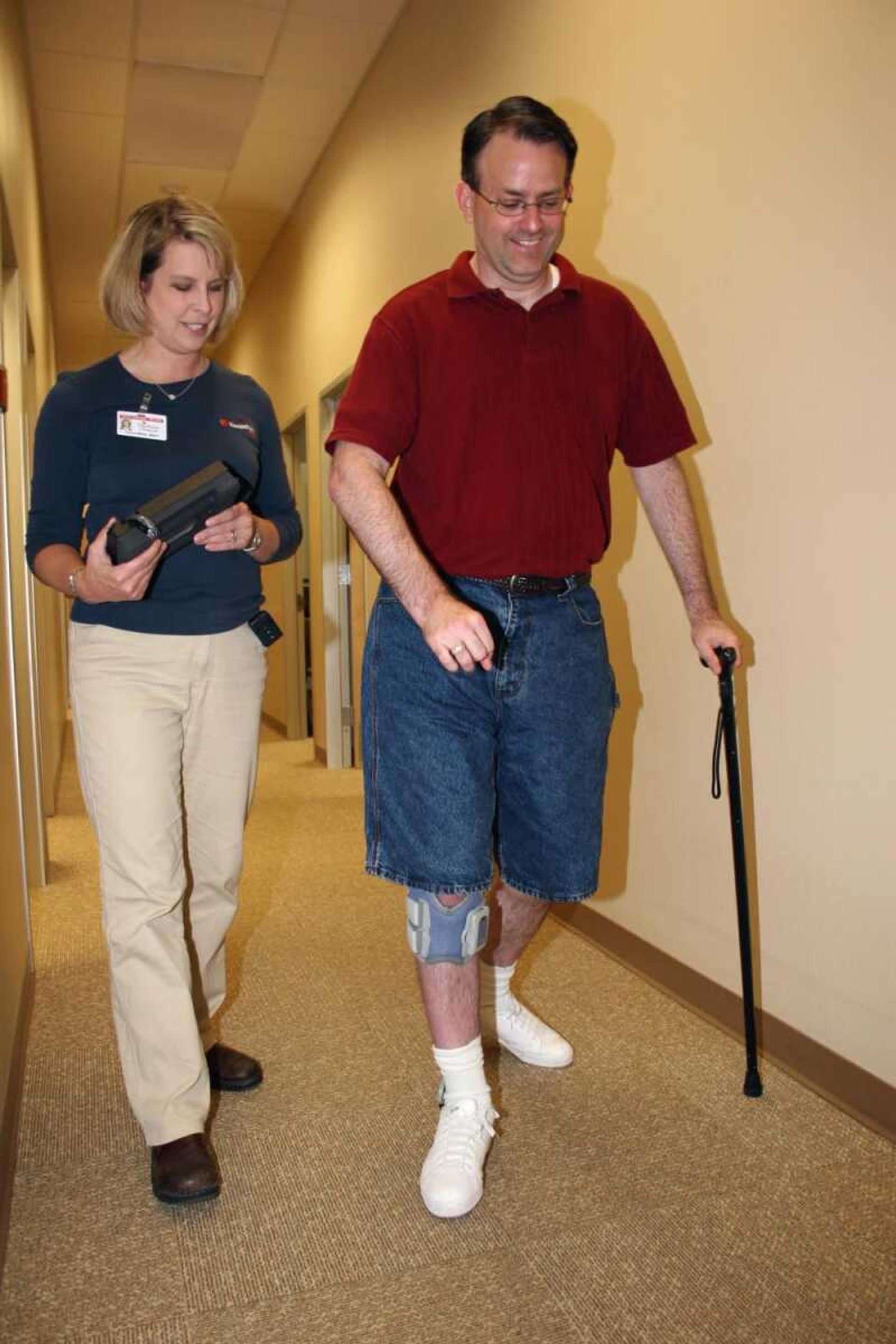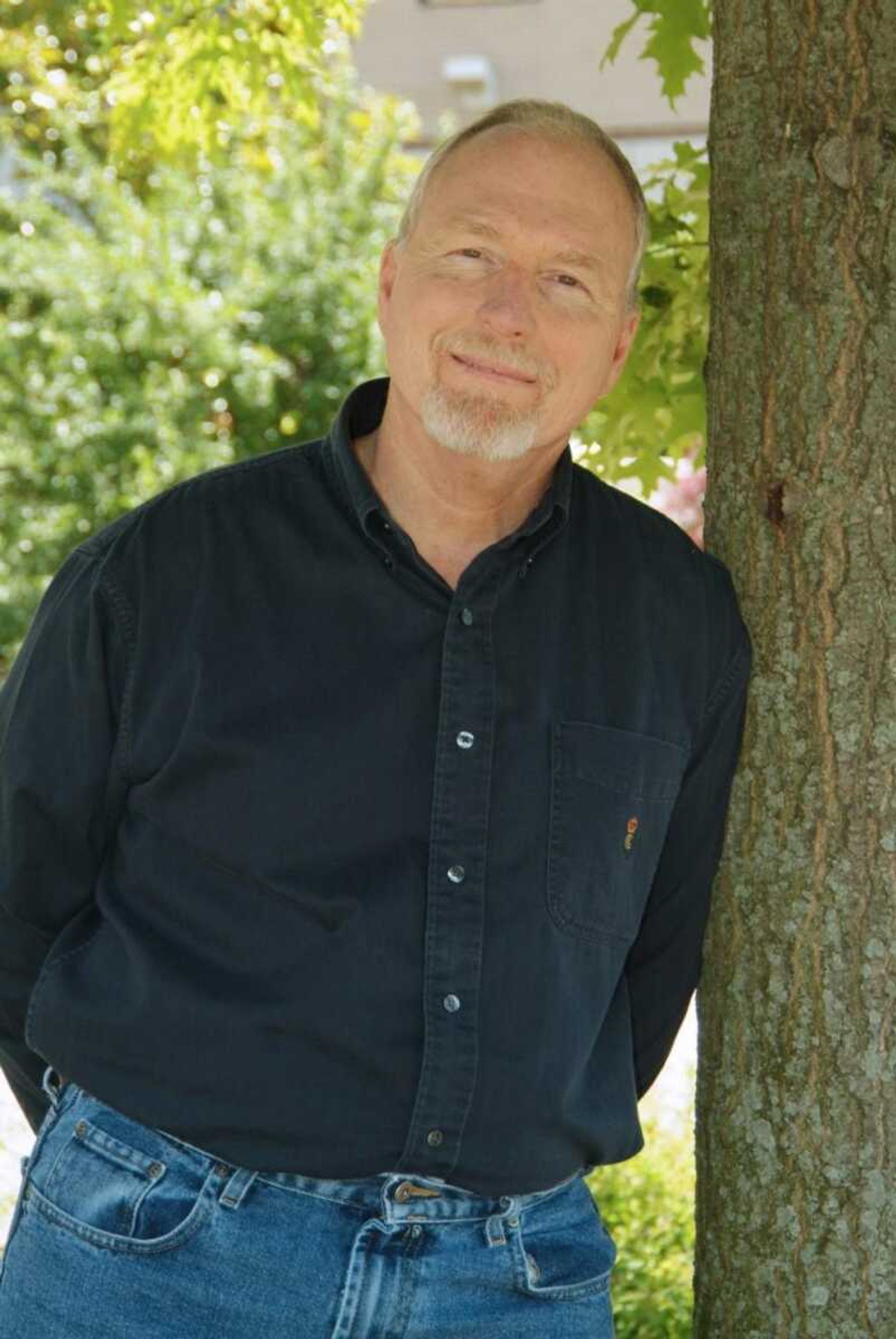~Two new innovations; two stories; two lives changed
---

One step at a time
After a stroke three years ago, Daniel Nuckolls has found a way to walk again
Daniel Nuckolls had a debilitating stroke in 2004 at the young age of 37.
"I couldn't talk; I was bedridden. I came home in a wheelchair," says Nuckolls, who lives in St. Louis.
Today he's learning to walk again with the help of a device found only in Cape Girardeau.
Southeast Missouri Hospital currently is the only hospital in Missouri with the NESS H200TM for hands and the NESS L300TM for legs. Both are distributed by Bioness Inc., and both use functional electronic stimulation (FES) to stimulate and activate muscles that have been affected by stroke or injury.
Brenda Nicolai, director of inpatient rehabilitation services at Southeast, says the technologies are used both in an acute rehabilitation program and outpatient services.
"Central nervous system injuries often result in a gait disorder called 'foot drop' which is the inability to raise the foot while walking," Nicolai says. "This results in dragging of the foot, instability and increased effort in moving."
The technology at Southeast helps patients regain a more natural gait, says Nicolai.
For hands, the stimulation technology works both as a neuroprosthesis that correctly positions the limb, and as an electric stimulation device that gently exercises the hand.
"With repeated use, the brain can relearn how to control hand muscles," Nicolai says.
Other potential benefits include increased hand function, reduced spasticity, increased local blood circulation, muscle re-education and increased range of motion.
After eight weeks of coming to Cape for therapy with his NESS, Nuckolls still has some drop in his right foot, but sees improvement. He is now working at home with it pretty much non-stop as well as working to regain the use of his right hand. He also works out on an elliptical machine for cardiovascular strength and endurance, and walks as much as possible with the support of his NESS.
After about two months of using the device, he said his walking speed has increased 20 percent. When he first began using it he said, "I felt liberated. I can walk somewhat but I have to have a cane or hold on to a wall."
"This is a breakthrough therapy that provides a major adjunct to traditional therapy for stroke, spinal cord and brain injured patients," Nicolai says.
Nicolai says there are "substantial clinical studies pointing to the value of neuromuscular re-education early in a patient's recovery." However, patients with chronic disabilities (one year or more post-injury to the central nervous system) also have demonstrated improvement in upper limb and lower limb function and impairments.
The neuroprosthesis is compatible with everyday footwear and is comprised of an electronic orthosis, foot sensor and control unit. The NESS L300TM delivers electrical pulses to the peroneal nerve, which controls movement of the ankle muscles, Nicolai explains, causing them to raise the foot at the appropriate phase of walking, preventing foot drop.
Nicolai says sophisticated software allows patients to "walk with greater confidence and ease, leading to increased mobility and independence."
The device is not yet covered by insurance. Nuckolls says his family pitched in to help pay for the $6,000 device. Devices can also be rented, he says. At some point, he says, he hopes to return to his work as a graphic designer.
"I will be able to walk again by myself," he says.
---

Heart control
Local patient undergoes new treatment for heart disease
In the past year, Bob Watson's heart rate escalated four times.
"It's scary and it's uncomfortable. " It changes your life a little bit," the Cape Girardeau man says.
In March, Watson underwent a new, minimally invasive treatment for atrial fibrillation -- a very fast, uncontrolled heart rhythm that affects around 5 million people in the U.S. -- at Saint Francis Medical Center.
Until recently, treatment options for AF included blood thinners, rhythm-control medications, pacemakers and a "Maze" procedure performed during open-heart surgery for other cardiac diseases. Patients with AF who do not respond to medication or cannot or will not take their medication may now have a new option in Southeast Missouri.
Cardiothoracic surgeon Dr. Edward M. Bender, on staff at Saint Francis Medical Center, is offering the Wolf MiniMaze procedure to treat AF. Named after Dr. Randall K. Wolf, the procedure combines an "ablation" method and the "maze" procedure, without performing open heart surgery or placing the patient on a heart-lung machine. "MiniMaze" technology utilizes a surgical probe and radio frequency cauterization, a technique incorporating electrical energy used in medical procedures for decades. The Wolf MiniMaze procedure can eliminate atrial fibrillation up to 91 percent of the time, says Bender.
Watson was a good candidate for the procedure. He has no history of hypertension, is active, and in general good health.
Watson's physician, Dr. Leeman Maxwell, had heard of the MiniMaze procedure and offered it as a possibility instead of drugs to control the irregular heartbeat. Watson enjoys bicycling and was concerned that if he were to fall, blood thinners would cause him to bleed too much from a minor scrape.
The MiniMaze procedure also allowed him to avoid open chest surgery, which would involve stopping his heart and the use of a heart-lung machine.
"The biggest part of the whole process was when they deflated both lungs instead of opening the chest," he said.
Surgeons made a small incision at each armpit to deflate first one lung, then the other. With one lung deflated, they used radio frequencies to block the extra signals to the heart's upper chamber, Watson said. He spent four days in the hospital. When he returned home, he had some temporary breathlessness and is now weaning himself off the drugs used to help him recover from the surgery. Always active, he works out on an elliptical walker and looks forward to getting back on his bike once he's fully recovered.
Watson said he has had a couple of instances when he felt that his heart was going to kick into high gear again, but it eventually subsided.
"That's what it's supposed to do," he sad. "It has changed the quality of my life. I'm 55 and I feel like I'm about 30. I want to stay that way as long as I can."
Bender says about 300,000 new atrial fibrillation cases are diagnosed each year. About 4 percent of individuals age 60 and older have the condition and about 9 percent of individuals 80 and older have it.
"There are a variety of factors that can trigger atrial fibrillation, such as high blood pressure, excessive use of stimulants like caffeine, alcohol consumption, obesity and heart disease," says Bender. "Individuals who suspect they may have atrial fibrillation should take the condition seriously and consult with their physician about it."
Connect with the Southeast Missourian Newsroom:
For corrections to this story or other insights for the editor, click here. To submit a letter to the editor, click here. To learn about the Southeast Missourian’s AI Policy, click here.






